




 |
 |
 |
 |
 |
DEVELOPMENT |
ONLINE
PROJECTS |
|||||
| A Brief look at Support Materials for Encaustic work | |
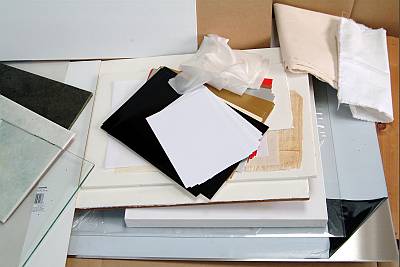 |
What surfaces can you use for encaustic artwork? The underlying base material will affect the ways in which the wax colours of encaustic paint can be worked. They will also affect the durability of the final piece. Flexible surfaces are good for hobby art but rigid ones are better for thicker waxes and longevity. |
| IMPORTANT TO UNDERSTAND: Different wax formulations will not behave in identical manner to one another. Some have better adhesion, some are more flexible, some are easy to apply in thin coatings or layers, others are far thicker and more impasto. Some will require hotter working temperatures, so when they hit a cold surface they drop temperature more quickly, affecting their adhesion and workability. There are many more variables, the point is that there are lots of variables which differ depending on what wax you choose, use or make! | |
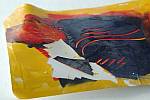 |
When it all goes wrong results could be like this! Poor adhesion, enbrittlement and blooming are all evident here. The flexible card was a total mistake for this wax type, which has later flaked off once the wax was in its final form. Always test your particular wax choice on any new support type. For longevity make flexible working supports rigid once completed. This removes any flexing strains. |
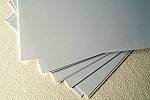 |
White non-absorbent card - like the encaustic
art painting card - offers wonderful opportunities for
work and reworking of many encaustic art wax types. It
is ideal for the encaustic
art wax blocks and recommended for them,
especially for hobby art works. For long term artwork it is best
to frame or make this support rigid by adhering to a wooden panel. One
advantage of not starting with a rigid surface is that the card can
be flexed and bent to enable particular effects to be achieved. Card
types of this nature can be obtained up to at least A1 size ; 594mm
(23") x
840mm (32") |
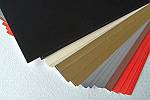 |
Colour faced high gloss card is available in many hues. The encaustic art range are an example. This card behaves in a similar manner to the white non-absorbent card although the coloured facing is only on one side. Available in at least A2 sizes ; 594mm (23") x 420mm (16") this card is interesting to work with and offers immediate differences to the ground and the reflective character of wax colours applied. Again and as with all the flexible support types, especially the slick surfaced ones, these should be made rigid for longevity to avoid potential flexing that might crack or flake thick or brittle wax areas. |
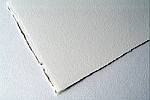  |
Water colour paper comes in a multitude of forms. Some wax is absorbed immediately it is applied, so in effect any absorbent support will become dirtied by the first wax application. Therefore, starting with the lighter colours that will be the ones to saturate the paper is often the best way to begin your piece. Adhesion is excellent because the wax penetrates the surface, but this makes it impossible to remove them which is the main working difference between this absorbent paper surface and the non-absorbent card above. Highly suited to many types of work approach but still benefits from making rigid once completed and better suited to surface rather than heavy impasto (thick) wax applications. |
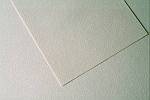 |
Textured absorbent papers or card stock expand the water colour paper potential, providing all manner of surface markings that add character to the work at hand. Sometimes cream or tinted colours, these support materials offer new potentials and the card stock particularly has less flexibility and more body strength to support wax colours. There are just so many available materials out there! |
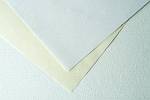 |
Parchment paper can be found in a number of toned or tinted hues and is not totally opaque. The translucency makes it interesting for back-lit work and it's particular surface absorbency can be such that the wax is faintly absorbed without saturating the surface. Delicate tones and very thin applications offer refined possibilities for lighter less imposing colour. |
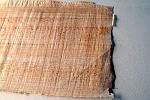 |
Papyrus or natural parchment has been around for millennia. It can be used with encaustic waxes but is a very flexible surface, so needs framing after completion or making rigid by adhesion to a board. Absorption of the wax can vary due to the natural qualities of the reed materials used in its making. |
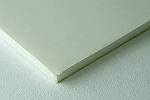 |
Foam core is a paper or plastic and foam combination. Some have a plastic feel to the slick surface. Black and white surfaces are available - maybe others? This material behaves as a non-absorbent surface that is almost rigid. It is interesting to use and very light to handle but the heat employed needs to be kept moderately low otherwise the whole thing can be made to buckle. Can be an excellent almost rigid backing material upon which to adhere card or paper encaustic works too. |
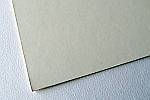 |
Conservation mount board is a cardboard used for mounting of artwork in archival conditions. You could also use regular mount board, but that contains acids that will affect the stability and colour of the product. The conservation board is absorbent and can be bought in a number of hues. It can be a variety of weights too. Its value is that the manufacture is carried out to minimise degrade through time, so longevity is optimised. The support is flexible but will not bend acutely. |
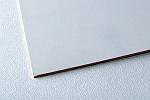 |
Line Board has a slick paper surface backed with a thick cardboard, often used by architects for line drawings in ink. There are many versions of this around but look for one that does not warp when heated. They are normally quite thick and pretty rigid. This support material is excellent for hot air gun work and hotplate work too. |
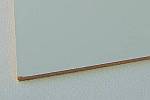 |
Masonite or Hard Board is a man-made fibrous wood type board that is pretty rigid but still has some flexibility in its span. Sold in most DIY stores, this brown material is usually slick on one side and texture impressed on the other (see below). It is also sold with the slick side pre-whitened ; often used in kitchen or bathroom cabinet furniture. |
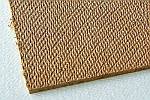 |
This the the back view of the masonite / hardboard. The board can be strengthened and made totally rigid by adding wooden cross slats or framing on the rear - glued into place to avoid damage to the surface. Raw hard board surfaces can be primed with an acrylic or gesso. Using wax direct onto the board will use more wax due to some absorption, but this does provide a strong key to the surface. |
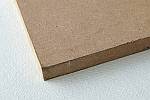 |
Medium Density Fiber Board or MDF for short, is another man made board, similar in some ways to hard board or Masonite but of a higher quality and available in much heavier thicknesses ranging from 3 or 4 mm to 25 mm. Again, boards can be stabalised by adding wooden strengthening slats or frames and priming can be with gesso or acrylics, etc. This is overall an excellent rigid material support for encaustic wax work. |
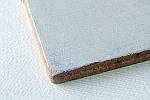 |
Ply wood is another easily available man made composite consisting of layers of thin wood sheets glued together with alternating grain direction patterns. This is a rigid board and quite stable but again it can be braced with further wooden batons, etc. The thicknesses vary but 6mm and up are good for encaustic work. The surface may have natural grain textures evident. Priming is as above for the other board types. |
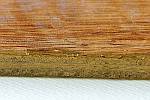 |
The edge of plywood reveals the laminated layers. The natural surface can be worked with wax directly with no grounding applied. Some absorption will occur providing a good key on which to build. However, the support surface will remain the natural wood colour, so if translucent colours are used this will show through and also does not provide a very powerful reflective luminosity underneath the colours. For opaque encaustic waxes this is no issue. |
 |
Block board is yet another available product, this time the inner portions are laminated sections of wood, finally covered with a skinning veneer of a single surface sheet. This is a very stable substrate and another good choice for encaustic work. Framing and bracing are often added and priming is again as the above board examples. This particular example has been coated with a white wax using hot air blowing to smooth out the final surface which is now ready for the artwork to be created. The added wax colours will bond into the existing saturated surface, forming a sound blend of waxes that are well keyed into the support already. |
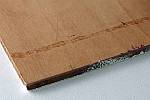 |
The natural surface of Block board has similar wood textures to the above Ply wood but is more stable and heavier to handle. It provides a good key to wax but can absorb quite a bit! Due to the density of the heavier wood type boards the material takes a long time to warm up and then a long time to cool, so is better suited to some technical approaches than others. |
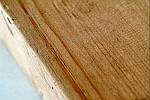 |
WOOD : the main original material that has survived since the encaustics of the ancients. They used thin sheets of wood for their portraits. Wood can warp, shrink, crack and so on through time, so consider carefully how natural wood has been prepared before you start painting or creating on it! Some oily woods will not provide good adhesion. Open grained woods will absorb more wax but give good keying. Wood texture can add or detract from your aim, so consider this as you choose the support. |
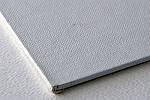 |
Canvas board is a canvas material stretched and glued to a strong cardboard core. It usually comes ready primed and is sold for acrylic and oil painting. It is pretty rigid although it does flex slightly. The primer coating is normally an acrylic which is basically non-absorbent and this can be fine but if molten waxes are applied to a cold surface they may not adhere very well in the long term. |
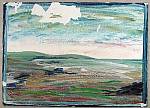 |
Flaking due to poor adhesion has resulted here where the hot wax was applied with a cold hair brush to the primer canvas board. Do ensure that you test your technique on any support before dashing forward into full creative output mode! It is important that the wax bonds well to the surface it is applied to and warming this canvas surface then applying the molten wax colour works better. |
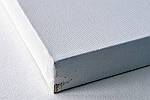 |
Stretch canvas is where a primed canvas (similar to the above canvas board) has been stretched over a wooden frame then stapled in place. Most of these frames come this small stretching pegs that enable the canvas to be tightened just that bit more. Some varieties of frame are very deep and enable the edges to become an intrinsic part of the artwork and often make any framing unnecessary. |
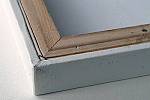 |
The better stretch canvas frames have the staples on the rear rather than the visible edges. These supports are available in many sizes and offer similar opportunities to the canvas board except that they are easier to hang when completed and also far lighter for the surface size. Ideal for thin wax hot air applications, hot air and roller work, etc. See an example done on stretch canvas : warm room |
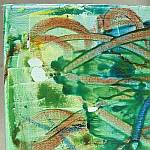 |
Poor adhesion of wax onto the stretch canvas can occur, like these areas of splattered drops which loosened and broke off from the surface (see the white spots in the example here). Again, as above, this is largely due to the temperature difference where the warm wax has cooled too fast on contact, this not creating a proper keying bond. So apply the wax carefully whilst molten to a warmed canvas surface (use a hot air gun) and keep the wax coatings relatively thin on this flexible stretched surface. Test your work by tapping the back of the canvas moderately to ensure that there is no potential weakness for flaking or cracking in visably hidden areas! |
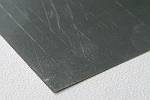 |
Aluminum is a metal used often in the printing industry in light flexible sheet form. This, or heavier more rigid panels can be used effectively for encaustic work but be diligent as experts say some pigments can interact and discolour when used in conjunction with this material. One excellent advantage is that the metal can be heated from behind easily. The surface might benefit from slight abrasive sanding to improve the key, otherwise adhesion could be poor. |
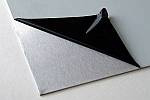 |
Stainless steel is another easily available metal that can come with a brushed surface that already provides good fissions for the wax to key into. This is a heavy material and in the long term the exact benefits of its use are indeterminate. Again, the material can easily be heated but will take time to cool as well. It will need to be framed or have batons attached to enable a panel to be formed for hanging, etc. |
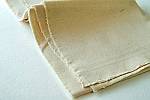 |
Raw canvas can be used with encaustic but will absorb large amounts of wax initially. It would be best to stretch this material over one of the rigid board types mentioned above (MDF for instance) so that the fabric is made stable and rigid. The initial impregnation of the canvas can be done with clear medium until saturation is achieved, then further colors can be introduced. The key is perfect and if saturated the longevity must also be wonderful. Excellent for some styles! |
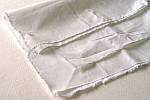 |
Poly cotton, cotton and other readily available material fabrics like satin are all good for encaustic work. There are many approaches, including wax print offs or wax transfers. The finer the weave then the finer the detail that this will hold. Heavier applications need the fabrics to be stretched over rigid board, but light work can be done with the fabric remaining as pliable and relaxed as is natural for it. Many embroiderers and creative fabric artists have used encaustic in combination with their fabric creations. |
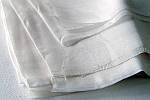 |
Silk is one of the finest materials available and can offer some beautiful results when used as the recipient of wax colours. The above fabric transfer technique combined with silk over-painting can be wonderful. Multi layered silk with wax on the various layers can also be very interesting. As with the other fabrics, the adhesion is perfect because the wax saturates the fibres so you just need to be careful not to overload the support with such thickness that cracks could occur (unless you want cracks in the work of course). |
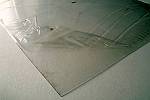 |
Clear or coloured plastics are available in many many forms these days and are yet another useful support. Plastics may be very flexible or fairly rigid depending on which ones you use. One advantage is that you can work the encaustic on one side of the clear plastic and present it from the other side, creating a natural protective sheeting in front of the fragile wax surface. Multiple sheets can be sandwiched with wax in between. Make thinner sheets rigid by framing to avoid flexing and possible flaking of the wax through time. Also know that many plastics are thermally sensitive, so higher temperature working is often not advisable (e.g. hot air gun). |
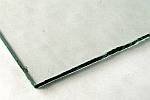 |
Glass is of course another fantastic clear medium that wax can be worked onto, but note that most glass will crack or even explode if over-heated, especially if the heat is localised. So for applications where heat is likely to cause this problem always use toughened glass - like the glass from an oven door that has been treated to tolerate high temperatures. As above, the artwork can be viewed from the unwaxed side too. Also all translucent or transparent supports can be displayed when finished with back lighting if desired. Glass has much to offer in this respect. |
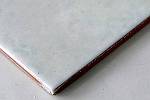 |
Ceramic tiles and glazed tiles or panels are another useful form of readily available material upon which encaustic wax can be worked. Some companies manufacture boards (search "claybord") covered in Gesso that are similar to this but not so liable to breakage and also proving a consistently good key. Experiment before attempting large work so that you are clear about the handling and that the methods you wish to use are suited to each support type. |
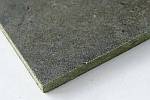 |
Slate or other natural stone surfaces also provide useful and interesting support materials for working of encaustic paints. These have been used in ancient times and encaustic was also used to decorate sculptures in the past. The wax type used will determine the way in which these materials can be useful to you. They can be difficult to heat or even warm if they are large in mass and once heated they take an age to cool again. |
This
brief peek into support possibilities only lightly scratches the
surface of the potentials around in this day and age. All in all
one can work onto a multitude of different support materials, each
offering an unique opportunity but not always one that majors in
longevity. The different waxes that can be used will interact in
unique manner with any of these supports. |
|
|